Democratizing architecture
Luis Beltrán del Río García and Andrew Sosa Martínez believe architecture should be for all.
June 23, 2020

San Marcos social housing, Guerrero, Mexico. Developed in collaboration with COOP Arquitectura and the German Embassy in Mexico City. Credit: Oscar Sanginés
Vrtical is a 2020 League Prize winner.
Mexico City-based Vrtical aims to expand the reach of architecture by developing creative design and construction methodologies that accommodate budgets large and small.
The League’s Catarina Flaksman and Sarah Wesseler spoke with them about their work.
*
Catarina Flaksman: Can you talk about how you’ve managed to have such a diverse array of clients, from NGOs to nonprofits to the government?
Luis Beltrán del Río Garcia: It’s been quite accidental. At the beginning, we did many social projects, because that’s what you do if you’re starting out and you don’t come from a privileged background with lots of connections. We started doing projects where there was a need for projects. We knocked on doors at NGOs.
We have a strong academic background. I did my master’s degree at the Technical University of Berlin and worked in the Habitat Unit with Renato D’Alençon Castrillón, where Francis Kéré and Ursula Hartig used to teach as well. So when Andrew and I got together, it was quite easy to start working on social projects. And somehow this started to scale up to private clients.
Our mantra comes from the title of a book by Cameron Sinclair and Kate Stohr, Design Like You Give a Damn. We are always excited to design new things. It doesn’t matter if there’s a low budget or a lot of money involved, because for us the fun part is the methodology. And we like to change methodologies quite often, according to the project we’re working on.
Sometimes we work on very different projects at the same time, which can feel a bit schizophrenic. We did two social housing prototypes for the German Embassy in the mountains of Guerrero. This is a really, really dangerous place—while we were working on the project, 43 students disappeared, right around the corner. And at the same time, we were developing a house in Beverly Hills. Sometimes we’d be traveling to Los Angeles in first class, and at other times we’d be going to Guerrero, not knowing if we would be coming back.
Flaksman: In your League Prize submission, you talked about the idea of democratizing architecture. Can you expand on this?
Andrew Sosa: We think about architecture as being similar to medicine. As a doctor, you have an obligation to help anyone who needs it. As architects, we should do the same.
Most people think that architecture is just for the higher classes. But we believe that as architects, we have a responsibility to help everyone.
Beltrán del Rio: We want to make our services accessible. Architects haven’t served the middle-income and lower classes; as a field, we only pay attention to people that have a lot of money. We really believe that this has to change.
Flaksman: Do you see this changing in Mexico, where there are so many high-quality social housing projects being built recently, for instance?
Beltrán del Rio: Yeah, it’s changing. The situation in Mexico is a bit awkward. In my master’s program we called it an anchor country—we are not a developed country, but we have a lot of money. It’s similar to India, Brazil, Egypt. This is relevant because for architecture you need two things: need and money. We have both.
Nowadays Mexican architecture is very interesting because young architects have the chance to actually practice and find ways to make things differently. There are a lot of young firms that come from the middle and lower classes, from public universities like UNAM, who are actually getting opportunities. And there is a lot of demand. So the language of architecture is changing here. It’s quite exciting.
Also, I know this is politically incorrect, but the informal economy helps bring new ideas to architecture. Overregulation is sometimes a problem.
Wesseler: Where do you see the most potential for democratization of the field in Mexico? Do you think architects themselves can make this happen? Or do top-down government programs, nonprofits, etc., need to play a major role?
Beltrán del Rio: I think it’s more a matter of people just wanting to change things. For example, in Oaxaca there’s an old tradition in the indigenous communities called tequio, when they get together once or twice a week to build each other’s houses or to do other types of work to benefit their community. So if a young architect arrives there and tells them, “I’ll do the design, you do the construction, and we’ll build the house with adobe,” the cost is quite low. Not to mention that the cost of labor in Mexico is quite low already.
It’s not always a matter of connecting with NGO programs. I really think it’s a matter of cheap labor, and of the will of young people to do this stuff. The country is wide; there are so many abandoned regions in Mexico where nobody will pay attention if you try to do something. So architecture students talk to their professors and go find somewhere to build; they take money out of their pockets to make it happen. It’s not a good business at all, but they do it.
Flaksman: How are you able to engage with the communities from the various contexts where you work? Have you developed specific engagement tools?
Sosa: We have a methodology for working with communities. First we talk with them to understand their needs, their understanding of their problems, and which opportunities they see. We list all these issues and combine them with quantitative information to understand how we can help them.
Beltrán del Rio: For Tlaxco Artisan Market, for instance, we proposed a municipal master plan, which was developed with the community. It was very simple. In this case, we separated people in different groups: one day we spoke only to the guys, the other day only to the children, one day to women and children, another day to women only, then to women and men, and finally to all of them together. It’s quite revealing, especially when you’re in a macho context where sometimes the guys don’t let their wife speak as they should.
But this is all basically by the book; it’s nothing new. I learned most of these participatory methodologies while I was doing my master’s degree, and I had the chance to work in Cairo with these methodologies developed by GIZ.
Actually, Andrew and I believe that participatory processes are a bit overrated. Often, they give people a license to demand things that you cannot accomplish. So much depends on money, construction systems, and other factors outside of the architect’s control. We’re more interested in designing, and in how the aesthetics of a building can change the community after it’s built.
Flaksman: Are people receptive when you come from outside to work in their communities? How do you see this relationship?
Beltrán del Rio: They are receptive, for the most part. For instance, the social housing project we did in Guerrero, which was our first participatory project, was revealing in so many ways. We worked with two communities, San Marcos and Zontecomapa. One community loved us, but the other thought that we were a political party, so they really didn’t like us. We saw many indications that we shouldn’t be there. We had a deal with the city leaders that they would cook for us, and the food was really badly cooked, for example. Sometimes they completely forgot to cook.
But in the end they liked what we did. And we were actually quite surprised, because we did two prototypes, one very similar to vernacular housing and the other very different from anything they had seen there. The NGOs here in Mexico City said, “Of course they’ll love the vernacular design.” They were really concerned about the other design, saying, “What is this? How is this community going to react to something so different?” But when we got there, they loved the new design and hated the vernacular one. They said it was just more of the same.

Zontecomapa social housing prototype, Guerrero, Mexico. Developed in collaboration with COOP Arquitectura and the German Embassy in Mexico City. Credit: Vrtical
We also did a participatory project with a Hare Krishna community in Cuerámaro, which was a completely different story. It was such a great experience. They helped us build their temple. The construction system for that project was quite intuitive. We really wanted them to think, “I put this brick here; I put this prefab concrete beam here; I did it myself, so this is my temple.” That system worked pretty well, and it helped us lower the project costs.
We are not Hare Krishna devotees, but because we were nice, open, we ate their food, etc., they thought that we were going to end up being devotees and living with them. So in the end they were not so happy, because we had to leave and go eat some tacos.
Flaksman: You also have a few renovation projects, including Tlaxco Market and a Barragan-designed building in Mexico City. How do you approach these projects? Is reuse an integral part of your practice?
Beltrán del Rio: We are fans of firms like Flores & Prats and Lacaton & Vassal. But even more than loving their work, we think it’s the future of architecture.
Sosa: It’s also very practical. If we can use the shell of an existing building, we can significantly lower the budget.
Beltrán del Rio: Reuse has become part of our methodology. In the case of the market, there was a building from the ’80s there that didn’t work very well. But it had good walls surrounding the whole plot. So we thought, we need to bring in light, create two courtyards, and build these new wooden beams above the whole structure.
It is a reality that the lifespan of a building is larger than the lifespan of a human. More and more, architects will have to deal with what already exists. Not to mention, of course, the ecological footprint of building.
The past generation of architects in Mexico paid no attention to existing buildings that were not considered architectural heritage, but you can always find all sorts of beauty if you pay attention. I believe there’s a new wave of architects that actually is observing their houses, for example—buildings that may be nothing super special, but that have interesting qualities. They may say, “This floor reminds me of my grandmother’s. Wouldn’t it be nice in a contemporary house?”
I always tell my students this: Ricardo Legorreta was a very important architect here, but he made everything orange, pink, and purple. It didn’t matter if the building was in Los Angeles, Madrid, Oaxaca—they’re all the same.
I find this very boring. Working with existing buildings means that you’re constantly doing different things.
Explore
Everything old is new again
For Miriam Peterson and Nathan Rich, adaptive reuse projects offer uniquely exciting design challenges.
Potable water and local power struggles in Honduras
Timothy Kohut reflects on alternative visions for community development in Tegucigalpa.
Francis Kéré lecture
The Berlin-based, Burkina Faso-born architect discusses his work.





